Origins of pressure-induced enhancement in thermal conductivity of hybrid inorganic–organic perovskites†
Abstract
Responses of materials to high pressures unveil important insight into their structure–property relationships that are otherwise masked under ambient conditions. Here, using atomistic simulations, it is shown that the thermal conductivity of methylammonium lead iodide can be drastically increased by more than an order of magnitude with applications of ∼60 GPa hydrostatic pressures. The insights gained from the molecular dynamics simulations suggest that although the inorganic constituents contribute significantly to heat flow at ambient pressure, the organic constituents are largely responsible for the drastic increase in thermal conductivity at higher pressures. The application of hydrostatic pressure leads to severe octahedral distortions resulting in higher degrees of confinement of the organic molecules and the concomitant hardening of their vibrational density of states to high frequencies encompassing a very broad spectral range that are otherwise unavailable at ambient pressure. This is shown to drastically improve the overall thermal conductivity even though the contributions from the inorganic constituents remain largely unchanged throughout the pressure range studied in this work.

- This article is part of the themed collections: 2021 Nanoscale HOT Article Collection and Editor’s Choice: Thermoelectric nanostructures


 Please wait while we load your content...
Please wait while we load your content...